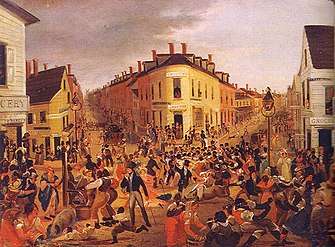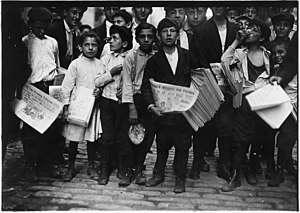Baxter Street Dudes
The Baxter Street Dudes was a New York teenage street gang, consisting of former newsboys and bootblacks, who ran the Grand Duke's Theatre from the basement of a dive bar on Baxter Street during the 1870s.[1] Led by founder Baby-Face Willie, gang members operated the Grand Duke's Theatre and established the venue as their headquarters.[2] Members of the Baxter Street Dudes wrote and performed plays, musicals and variety shows which were enjoyed by other street toughs and slummers throughout the city.[3][2][4] The theater house eventually became a popular underworld hangout, from which the gang found financial success.
| Founders | Baby-Faced Willie |
|---|---|
| Founding location | New York City |
| Years active | ~1870s |
| Territory | Baxter Street |
| Membership | Newsboys, bootblacks |
| Activities | Tax evasion, thievery, entertainment |
| Rivals | Mulberry Blend |
History

During the time when Grand Duke's Theatre was at its peak, many movements occurring across the United States influenced the organization's ability to function. Abraham Lincoln was in office, the population was divided between North and South, and the volume of immigrants settling in the Northeastern region of the United States was massive. Immigration from Europe, increased the population significantly, changing the culture of the city making it more diverse. New York and neighboring states were rapidly developing throughout national conflict, with notable achievements including the introduction of the elevator and the creation of the first telephone line.
Street Children in New York
In the 1870s, America experienced a depression that forced many people, including children, to live on the streets. About 5,000 to 10,000 boys were estimated to be living on the streets of New York by the 1850s. The Children’s Aid Society reported around 15,000 homeless youths in 1870.[6] Children were uneducated and treated poorly, enabling theft, mainly in the form of pick-pocketing. The number of pickpocket trials in the New York court rose from 52 in 1859 to 242 in 1876. Most children involved with these cases were between the ages of 15 to 24.[6]

Many children began their own newspaper-selling enterprises, commonly known as newsboys. Children around the age of ten purchased newspapers from local publishers and sold them to passers-by on the street. Newsboys often organized together to protect themselves and their earnings.[8] Older adolescent males hired and managed younger boys and formed their own community of street children.[6]
A group of teenagers on Baxter street, consisting of mainly newsboys, formed The Baxter Street Dudes with fellow neighborhood members, experiencing a similar struggle during a dark economic period.[8][9][10]
Baxter Street
In the 1800s, the Baxter Street Dudes operated and expanded into two districts within the Five Points, including Baxter Street and Mosco Street. A well-known detention complex, The Tombs, was situated in the Five Points neighborhood, and held many high profile criminals.
Despite the active gangs in the late 1870s that enabled Baxter Street to earn a dangerous reputation, The Baxter Street Dudes were a nonviolent group of individuals. The Baxter Street Dudes experienced minor quarrels at the Grand Duke's Theatre between rival street organizations known for mugging, murdering, and tormenting citizens and other street thugs.[11] Throughout performances by the Baxter Street Dudes at Grand Duke's Theatre, members of fellow gangs were known to disrupt actors by causing physical altercations, which eventually led to the foreclosure of the theater by NYPD. In addition to audience members impacting theater functionality, the Baxter Street Dudes refused to pay amusement taxes to the city.[12][13]
The gang has been portrayed in a number of historical novels including Dreamland (2003) by Kevin Baker, The Five Points Concluded (2003) by Rocco Dormarunno, Sweet America: An Immigrants Story (2004) by Steven Knoll and Heyday: A Novel (2007) by Kurt Andersen.
The Grand Duke's Theatre
The Baxter Street Dudes started the Grand Duke's Theatre in 1872 under a bar at 21 Baxter Street in Manhattan.[1] They performed to audiences of up to 300 people, selling tickets at 5¢ a person to 25¢ for private booths. These prices eventually rose to 20¢ a seat and $5 a booth because of their increased popularity.[1] Demand for theater grew in New York City and the Baxter Street Dudes began making a $70 a week which was usually donated to charity.[1]
When the Grand Duke Alexei Alexandrovich of Russia visited New York, the boys named their establishment the Grand Duke’s Theatre after him.[14] Members of the gang would steal their props and costumes, spending very little on their production.[10] Despite the poor quality of their stage equipment, they consistently had popular performances for several years.[9] Their fame as a performing group led them to travel outside of New York and performed in other cities at theaters, churches, and schools.[1]
New York began charging $500 for theater licensing in 1872, claiming slum theaters were negatively influencing the younger generations.[15] The theater was challenged in court for not paying the fee in 1874 but its owners were able to win and stay in business.[1][15]
Evolution of New York Street Gangs
- 1780s: As the American Revolution concluded, non-violent street gangs became prominent in the New York.[11]
- 1820s: Violent street gangs emerged in New York, influenced by immigration from Northern Europe, Western Europe, Poland, Italy, and Ireland.[11]
- 1880s: Tremendous immigration patterns of the Jewish and Italian population enabled a high density of individuals to dwell in slums of New York. With great shortages of housing opportunities, crime elevated throughout New York, and the correlation between slum dwellers and crime activity was noticed. Common crimes included drug distribution, political corruption, and theft.[11]
- 1910s: Mafia members stabilized in New York after moving from New Orleans. Such strength throughout the Mafia forced smaller, younger street groups to be overpowered and exposed as amateur criminals.[11]
- 1950s: The diminishing numbers of youth street gangs in New York enabled other demographics to compete for local power. Although many street gangs were diminished by the Mafia, white male-dominated groups began to form as new pressure emerged. African Americans from the South seeking employment opportunities threatened white male street gangs, which enabled the establishment of even more groups who were dedicated to fight racial integration.[11]
- 1960s: Brooklyn, New York was forced to develop low-income infrastructure due to high immigration patterns. With large groups of Latin Americans and Puerto Ricans populating the area, Brooklyn encountered extreme gang violence as more organizations formed based around social class and race. Throughout this decade of immense immigration of Latinos and African Americans, the two populations made up two thirds of the gang population in New York.[11][16]
- 1990s: After years of African American and Latino domination of New York, Hispanics emerged as the largest minority population in the state. This post World War II decade experienced incredible efforts to fight gang violence in New York; city officials strived for urban renewal by eliminating slums and the establishment of low-income housing.[11]
References
- "The Grand Duke Theatre.; a Once Noted Place of Amusement Makes Room for a Tenement". The New York Times. 1887-07-28. ISSN 0362-4331. Retrieved 2018-05-17.
- Maffi, Mario. Gateway To The Promised Land: Ethnic cultures of New York's Lower East Side. Amsterdam: Rodopi, 1994. (pg. 90) ISBN 90-5183-677-5
- Donovan, Frank D. Wild Kids: How Youth Has Shocked Its Elders--Then and Now. Harrisburg: Stackpole Books, 1967. (pg. 176)
- Cullen, Frank; Florence Hackman and Donald McNeilly. Vaudeville, Old & New: An Encyclopedia of Variety Performers in America. Vol. 1. New York: Routledge, 2007. (pg. 101) ISBN 0-415-93853-8
- Catlin, George (1827), Five Points, retrieved 2018-05-22
- Gilfoyle, Timothy J. (2004). "Street-Rats and Gutter-Snipes: Child Pickpockets and Street Culture in New York City, 1850-1900". Journal of Social History. 37 (4): 853–882. doi:10.1353/jsh.2004.0044. JSTOR 3790070.
- Hine, Lewis (1910-07-07), Newsboys and newsgirl. Getting afternoon papers. New York City., retrieved 2018-05-21
- Anbinder, Tyler (2001). Five Points: The 19th-century New York City Neighborhood that Invented Tap Dance, Stole Elections, and Became the World's Most Notorious Slum. Simon and Schuster. ISBN 9780684859958.
- Maffi, Mario (April 1995). Gateway to the Promised Land: Ethnic Cultures on New York's Lower East Side. NYU Press. ISBN 9780814755099.
- Asbury, Herbert (July 2008). The Gangs of New York: An Informal History of the Underworld. Vintage Books. ISBN 9780307388988.
- Howell, James (May 2010). "HISTORY OF STREET GANGS IN THE UNITED STATES" (PDF). National Gang Center Bulletin. Retrieved May 17, 2018.
- Harlow, Alvin F. Old Bowery Days: The Chronicles of a Famous Street. New York and London: D. Appleton & Company, 1931. (pg. 482)
- Knowles, Mark. Tap Roots: The Early History of Tap Dancing. McFarland, 2002. (pg. 176) ISBN 0-7864-1267-4
- Farrow, Lee A. (2014-12-15). Alexis in America: A Russian Grand Duke's Tour, 1871-1872. LSU Press. ISBN 9780807158401.
- Granshaw, Michelle (January 2014). "The Mysterious Victory of the Newsboys: The Grand Duke Theatre's 1874 Challenge to the Theatre Licensing Law". Theatre Survey. 55 (1): 48–80. doi:10.1017/S0040557413000537. ISSN 0040-5574.
- Bankston, Carl L. "Youth Gangs and the New Second Generation". Cite journal requires
|journal=(help)